Works of art at Malescasse
In art, as for wine, it’s all about passion. At Malescasse, art and wine are closely related, and combine to create a perfect balance between tradition and modernity, dynamism and esthetism. A day at Malescasse is a journey throughout pleasure, senses and emotions. Bernar Venet, Ingo Maurer, Schlosser, Braun Vega, … Some of the finest contemporary artists and designers signed works shown at Malescasse, some of them specially created for the domaine.
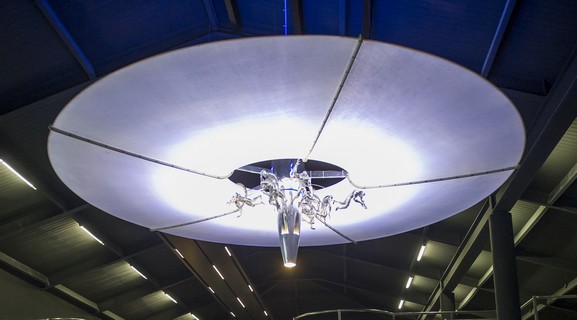
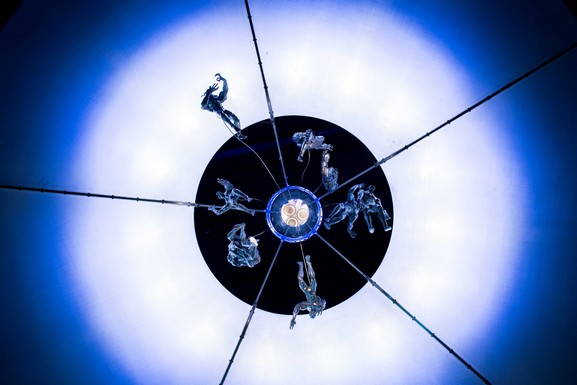
Ingo Maurer –
Atomium Suspension Monumentale, 2006
The winery of Malescasse Castle welcomes you with the chandelier Atomium Suspension Monumental (2006) by the German artist-designer Ingo Maurer, created for the Atomium of Brussels during its renovation. This artist is one of the first to work on boundaries between art and design by creating luminous objects. Aliens’ bodies, suspended in a circle around the bulb, recall the conquest of space, the faith in technology and in the future which are symbols of the Brussels building for which the work was designed. At the edge of the art object and the utilitarian object, this chandelier fits perfectly into the environment made of steel from the vats of precious vintage.
Bernar Venet –
223.5° ARC X 10, 2014
After the end to his so-called “conceptual” period in 1971 in which he sought to eliminate any possible interpretation of the work of art by summoning mathematics, geometry or economics, Bernar Venet returned to the studio in 1976. He then developed a work on the line which became the central element of his work. Curved or straight, broken, aligned or arranged in battle, the lines take shape in Corten steel, the artist’s favorite material.
For Bernar Venet, “the line is what comes before the superfluous”. His monumental sculptures thus bear the inscription of the nature of the sculpted object (angle or arc) and the degree of inclination of the steel. With no other meaning than that of its shape and size, the sculpture, entitled “223.5° ARC X 10” (2014), which unfolds in the courtyard of Château Malescasse creates a striking dialogue with its environment: sharing the same majesty as the neo-classical charterhouse of Malescasse and the same precision as its gardens, it nevertheless contrasts with the linearity of the building by the softness of its curves and with the mineral aspect of the place by its very industrial esthetic.
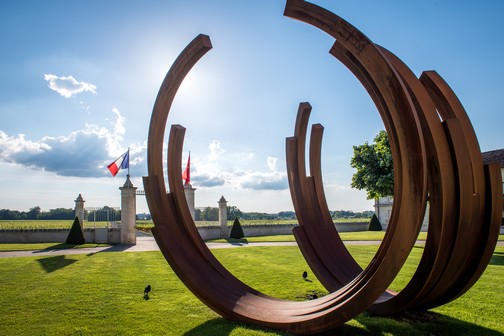
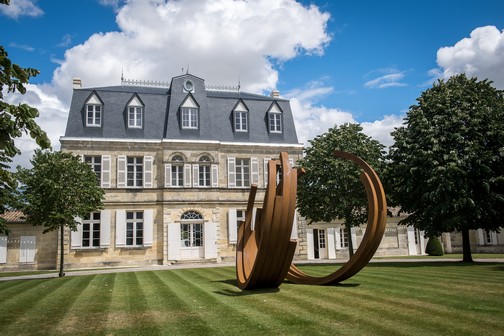


Bernar Venet –
223.5° ARC X 10, 2014
After the end to his so-called “conceptual” period in 1971 in which he sought to eliminate any possible interpretation of the work of art by summoning mathematics, geometry or economics, Bernar Venet returned to the studio in 1976. He then developed a work on the line which became the central element of his work. Curved or straight, broken, aligned or arranged in battle, the lines take shape in Corten steel, the artist’s favorite material.
For Bernar Venet, “the line is what comes before the superfluous”. His monumental sculptures thus bear the inscription of the nature of the sculpted object (angle or arc) and the degree of inclination of the steel. With no other meaning than that of its shape and size, the sculpture, entitled “223.5° ARC X 10” (2014), which unfolds in the courtyard of Château Malescasse creates a striking dialogue with its environment: sharing the same majesty as the neo-classical charterhouse of Malescasse and the same precision as its gardens, it nevertheless contrasts with the linearity of the building by the softness of its curves and with the mineral aspect of the place by its very industrial esthetic.
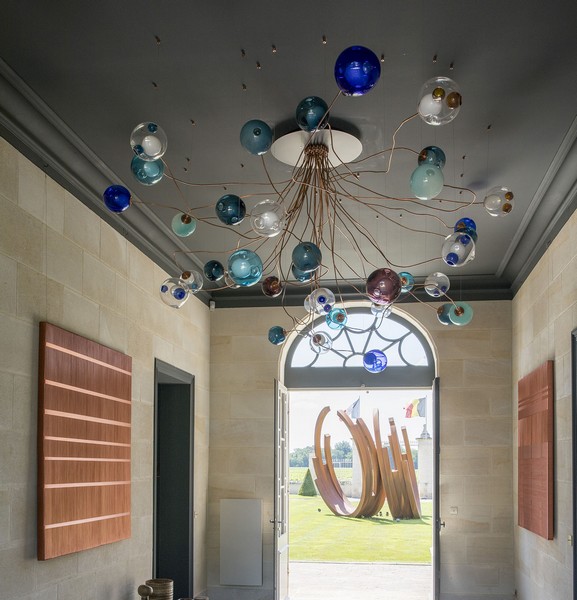
Bocci – Malescasse Hall lightening
Founded in 2005 in Vancouver by Randy Bishop et Omer Arbel, Bocci is a light design brand that produces real “light sculptures” based on physical and chemical studies of material. Collections are simply named after digits, emphazing their chronological position in the creative process of Bocci’s artistic director, architecte et designer Arbel, and are mainly made in hand-blown glass.
Herman Braun Vega –
Le déjeuner in Central Park (Manet), 1989
As a master of interpictoriality*, Herman Braun-Vega revisits, with a certain irony, the masterpieces of Western figurative painting. Herman Braun-Vega convokes the memory of the spectator by referring to the history of painting, to the history of the world and confronts it with his own daily life.
The artist invites himself here to Manet’s Déjeuner sur l’herbe, he frames a new horizon and solicits unexpected characters and artifacts, often revealing his native land, Latin America. With great freedom, Herman Braun-Vega’s luminous painting superimposes distant worlds and thus creates an artistic, historical and social crossbreeding.
*(the reproduction of a pictorial work -or part- within another, such as a quotation in the painting)
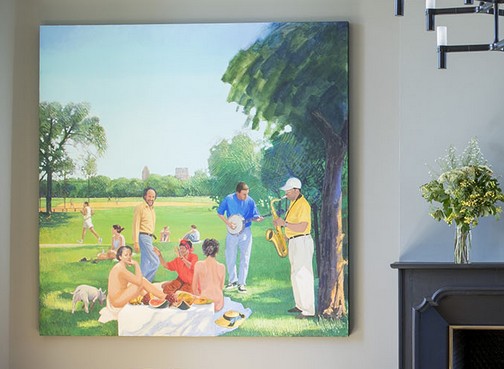

Herman Braun Vega –
Le déjeuner in Central Park (Manet), 1989
As a master of interpictoriality*, Herman Braun-Vega revisits, with a certain irony, the masterpieces of Western figurative painting. Herman Braun-Vega convokes the memory of the spectator by referring to the history of painting, to the history of the world and confronts it with his own daily life.
The artist invites himself here to Manet’s Déjeuner sur l’herbe, he frames a new horizon and solicits unexpected characters and artifacts, often revealing his native land, Latin America. With great freedom, Herman Braun-Vega’s luminous painting superimposes distant worlds and thus creates an artistic, historical and social crossbreeding.
*(the reproduction of a pictorial work -or part- within another, such as a quotation in the painting)
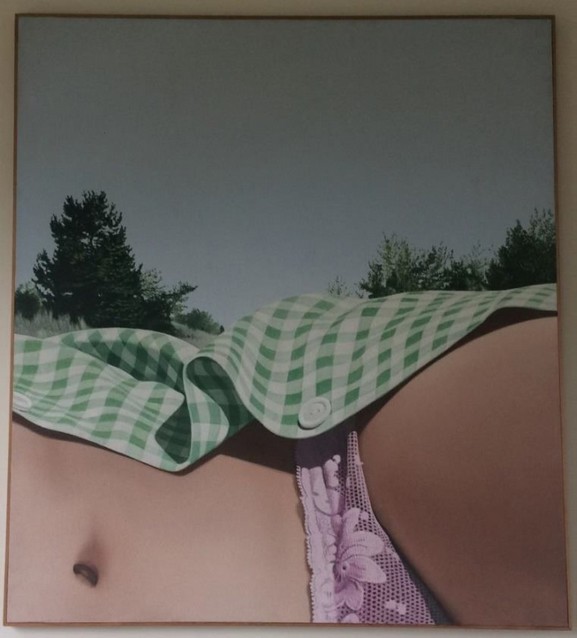
Gérard Schlosser –
J’ai faim, 1977 / Tu la vois toi l’alouette ? 1976
Commited to the narrative figuration, Gérard Schlosser paints reality. He fragments it to make the essential remain, between enigma and evidence. On symptomatic square canvases, Schlosser’s work invites us to contemplate a hyperrealist painting marked with a gentle romanticism. Like a praise of laziness and in a silent observation, the attention is directed on the beings, their bodies, their attitudes, their aspirations to happiness. The titles J’ai faim (I am hungry) and Tu la vois toi l’alouette ? (You, Do you see the lark ?) can be read and heard like voice-overs in the cinema, the painter’s flash of wit that allows the viewer to go beyond the image, towards an elsewhere…
Alice Anderson – (Pas de titre)
Born in 1976, Alice Anderson is a franco-british video maker. She mainly work with copper wire. Until 2007, she made several movies, but then started to make painting with her own body parts. In 2011, she started to cover objects with copper wire (guns, cars, pipes..). Doing so, she wants to “memorize” objects into time to keep their physical attributes. During a display in London, Alice Anderson invited visitors to mummify a Ford Mustang, a collective work of art that lasted 3 months.
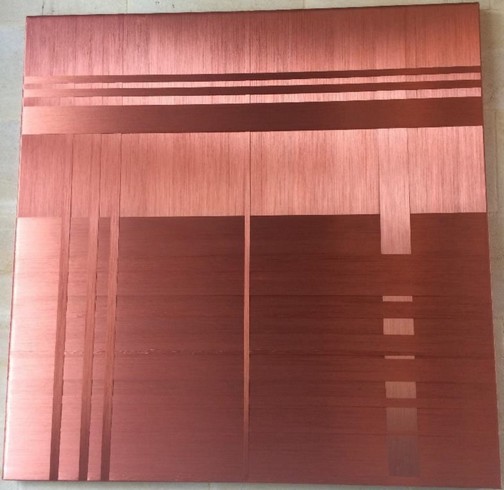

Alice Anderson – (Pas de titre)
Born in 1976, Alice Anderson is a franco-british video maker. She mainly work with copper wire. Until 2007, she made several movies, but then started to make painting with her own body parts. In 2011, she started to cover objects with copper wire (guns, cars, pipes..). Doing so, she wants to “memorize” objects into time to keep their physical attributes. During a display in London, Alice Anderson invited visitors to mummify a Ford Mustang, a collective work of art that lasted 3 months.
